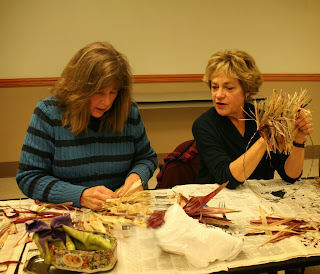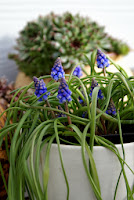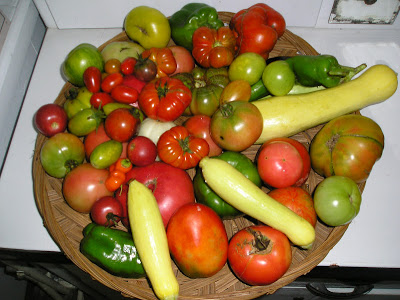| Cornhusk Dolls from Workshop (L) and Samples (R) |
On Saturday, October 26, the Master Gardeners of Penn State, Franklin County held a Cornhusk Doll and Wreath Workshop and, while there were 15 attendees, none were children.
 |
| Small cornhusk dolls (5" high) made by Carol Kagan |
 |
| Master Gardener Charlie White Making Cornhusk Dolls |
 |
| Krissy Castillo with Her Doll |
Krissy Castillo, Greencastle, attended after an invitation from her friend, Linda Keefer. They chose to start with making the dolls. Keefer said "small ones [dolls] could be used on Christmas trees" and others agreed that would be pretty. Keefer, also from Greencastle, took the Master Gardener Victory Garden workshop this year and noted she really enjoyed it.
 |
| Finished Sample Wreath |
Master Gardener Barbara Boyer led the wreath-making with a brief demonstration of the very easy technique. Cornhusks were stripped and soaked then torn into strips. The strips were tied with a simple tassel loop around a metal wreath ring.
 |
| Coat Hanger Wreath Frame |
Although there is a link below where the crimped wreath rings are available, any simple wire ring from a craft store would do. Why buy? If you still have a wire coat hanger, form it into a circle and use the hook as your hanger.
| Master Gardener Barbara Boyer Led Wreath-Making |
Boyer discussed and displayed a number of natural elements that could be used for embellishments including gum tree pods, dried cones, milkweed pods, and dried flower heads.
The availability of Indian corn purple-hued cornhusks added to the unique and different styles of both the wreaths and dolls. Some dolls had hair of dried cornsilk tucked under their bonnets and others had purple aprons and hats. There was a mix of purple and natural cornhusks on most wreaths. While some chose to use forks to shred the husks to a more fringed look, others left the husks wider and fuller.
| A fringed look |
Currently a Master Gardener trainee, Ruth Young from Blairs Mills, noted that she had a metal door and thought this wreath would "be light enough to hang on it." While Kathy Rodgers and Theresa Reichard, both from Waynesboro, like that it will "fit between the front door and storm door."
 |
| Kathy Rodgers (L) and Theresa Reichard work on their wreaths. |
Erica Hildabridle will put her wreath on the door until the Christmas season. She likes the natural look of the cornhusks making "changing the embellishments" for each season easy.
| Cornhusk Flower Embellishment |
Most wreaths were headed for the makers' front doors but Jane Weigle, a Master Gardener from Shippensburg, was making a gift. "My daughter just gave birth," she said. "She likes crafts and I thought I would make one for her since she doesn't have the time right now."
| Barbara Boyer did a good job on her first workshop. |
Photos: Carol Kagan
For more Information:
Cornhusk Dolls
Craft Revival: Shaping Western North Carolina Past and Present- Cornhusk Crafts
Children's Discovery Museum: Making Cornhusk Dolls
Cornhusk Wreaths
Make and Takes: Cornhusk Wreaths (Using a green styrofoam form from a dollar store)
Martha Stewart: Cornhusk Wreaths (Very different with dyed husks)
Chickens in the Road: Cornhusk Wreath (different technique and very rustic look)
Crimped Wreath Rings
Maine Wreath Company (online)























